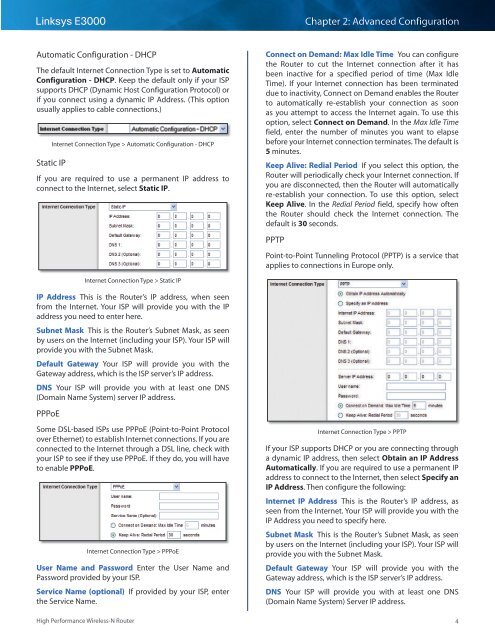Create successful ePaper yourself
Turn your PDF publications into a flip-book with our unique Google optimized e-Paper software.
Linksys <strong>E3000</strong><br />
Chapter 2: Advanced Configuration<br />
Automatic Configuration - DHCP<br />
The default Internet Connection Type is set to Automatic<br />
Configuration - DHCP. Keep the default only if your ISP<br />
supports DHCP (Dynamic Host Configuration Protocol) or<br />
if you connect using a dynamic IP Address. (This option<br />
usually applies to cable connections.)<br />
Static IP<br />
Internet Connection Type > Automatic Configuration - DHCP<br />
If you are required to use a permanent IP address to<br />
connect to the Internet, select Static IP.<br />
Connect on Demand: Max Idle Time You can configure<br />
the Router to cut the Internet connection after it has<br />
been inactive for a specified period of time (Max Idle<br />
Time). If your Internet connection has been terminated<br />
due to inactivity, Connect on Demand enables the Router<br />
to automatically re-establish your connection as soon<br />
as you attempt to access the Internet again. To use this<br />
option, select Connect on Demand. In the Max Idle Time<br />
field, enter the number of minutes you want to elapse<br />
before your Internet connection terminates. The default is<br />
5 minutes.<br />
Keep Alive: Redial Period If you select this option, the<br />
Router will periodically check your Internet connection. If<br />
you are disconnected, then the Router will automatically<br />
re-establish your connection. To use this option, select<br />
Keep Alive. In the Redial Period field, specify how often<br />
the Router should check the Internet connection. The<br />
default is 30 seconds.<br />
PPTP<br />
Point-to-Point Tunneling Protocol (PPTP) is a service that<br />
applies to connections in Europe only.<br />
Internet Connection Type > Static IP<br />
IP Address This is the Router’s IP address, when seen<br />
from the Internet. Your ISP will provide you with the IP<br />
address you need to enter here.<br />
Subnet Mask This is the Router’s Subnet Mask, as seen<br />
by users on the Internet (including your ISP). Your ISP will<br />
provide you with the Subnet Mask.<br />
Default Gateway Your ISP will provide you with the<br />
Gateway address, which is the ISP server’s IP address.<br />
DNS Your ISP will provide you with at least one DNS<br />
(Domain Name System) server IP address.<br />
PPPoE<br />
Some DSL-based ISPs use PPPoE (Point-to-Point Protocol<br />
over Ethernet) to establish Internet connections. If you are<br />
connected to the Internet through a DSL line, check with<br />
your ISP to see if they use PPPoE. If they do, you will have<br />
to enable PPPoE.<br />
Internet Connection Type > PPPoE<br />
<strong>User</strong> Name and Password Enter the <strong>User</strong> Name and<br />
Password provided by your ISP.<br />
Service Name (optional) If provided by your ISP, enter<br />
the Service Name.<br />
High Performance Wireless-N Router<br />
Internet Connection Type > PPTP<br />
If your ISP supports DHCP or you are connecting through<br />
a dynamic IP address, then select Obtain an IP Address<br />
Automatically. If you are required to use a permanent IP<br />
address to connect to the Internet, then select Specify an<br />
IP Address. Then configure the following:<br />
Internet IP Address This is the Router’s IP address, as<br />
seen from the Internet. Your ISP will provide you with the<br />
IP Address you need to specify here.<br />
Subnet Mask This is the Router’s Subnet Mask, as seen<br />
by users on the Internet (including your ISP). Your ISP will<br />
provide you with the Subnet Mask.<br />
Default Gateway Your ISP will provide you with the<br />
Gateway address, which is the ISP server’s IP address.<br />
DNS Your ISP will provide you with at least one DNS<br />
(Domain Name System) Server IP address.<br />
4


